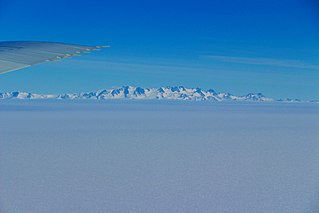Dufek Massif: Difference between revisions
Created page with "{{territory|BAT}} The '''Dufek Massif''' is a part of the Pensacola Mountains in Queen Elizabeth Land, within the mainland Antarctic lands of the British Antarctic T..." |
|||
| (One intermediate revision by the same user not shown) | |||
| Line 1: | Line 1: | ||
[[File:Dufekmassif (30745595952).jpg|right|thumb|320px|Dufek Massif in the distance]] | |||
{{territory|BAT}} | {{territory|BAT}} | ||
The '''Dufek Massif''' is a | The '''Dufek Massif''' is a small mountain range amongst those which constitute the [[Pensacola Mountains]] of [[Queen Elizabeth Land]] in the [[British Antarctic Territory]]. It is a rugged, largely snow-covered massif 27 nautical miles long in the north of the Pensacola Mountains, close to the shore of the frozen [[Weddell Sea]], standing to the west of the [[Forrestal Range]]. | ||
These mountains were seen from the air from a United States Navy P2V Neptune patrol aircraft on a nonstop transcontinental flight from McMurdo Sound (in New Zealand's Ross Dependency) to the Weddell Sea and back on 12 January 1956, as part of the United States Navy's 'Operation Deep Freeze'. | |||
The range is named after Rear-Admiral George John Dufek of the United States Navy (1903-77), Commander, the United States Navy Task Force 43, in Operation Deep Freeze, 1955-59 (whicjh included the first aircraft landing at the [[South Pole]]), and Officer-in-charge of the United States Antarctic Research Program, 1957-58; navigator in USS Bear of the United States Antarctic Service; Commander of icebreaker task force establishing weather stations in Canadian Arctic, 1946 and 1948; member of the United States Navy Operation 'Highjump', 1946-47 (under Rear-Admiral Richard E. Byrd); author of 'Operation Deepfreeze' (1957). | |||
The range was again seen from the air in October 1957 and surveyed from the ground in December 1957 by US International Geophysical Year personnel from 'Ellsworth Station'. | |||
==Geography== | |||
The range covers 4,500 square miles and its highest point is [[England Peak]], at 7,054 feet. Other notable local terrain features include [[Kelley Spur]], a rock spur 2 nautical miles east of [[Spear Spur]] on the south side of Dufek Massif. | |||
==Mountains== | |||
Mountains and features of the massif include: | |||
*The [[Boyd Escarpment]]: | |||
{| | |||
|- | |||
| | |||
*[[Bennett Spur]] | |||
| | |||
*[[Cox Nunatak]] | |||
| | |||
*[[Rankine Rock]] | |||
|} | |||
{| | |||
|- | |||
| | |||
*[[Alley Spur]] | |||
*[[Aughenbaugh Peak]] | |||
*[[Brown Nunataks]] | |||
*[[Cairn Ridge]] | |||
*[[Carlson Buttress]] | |||
*[[Clemons Spur]] | |||
*[[Clinton Spur]] | |||
*[[Czamanske Ridge]] | |||
*[[Davis Valley]] | |||
*[[Edge Glacier]] | |||
| | |||
*[[Enchanted Valley]] | |||
*[[England Peak]] | |||
*[[Ford Ice Piedmont]] | |||
*[[Forlidas Pond]] | |||
*[[Forlidas Ridge]] | |||
*[[Foundation Ice Stream]] | |||
*[[Frost Spur]] | |||
*[[Hannah Peak]] | |||
*[[Jaburg Glacier]] | |||
*[[Jaeger Table]] | |||
| | |||
*[[Kelley Spur]] | |||
*[[Kistler Valley]] | |||
*[[Lewis Spur]] | |||
*[[Neuburg Peak]] | |||
*[[Nutt Bluff]] | |||
*[[Petite Rocks]] | |||
*[[Preslik Spur]] | |||
*[[Pyroxenite Promontory]] | |||
*[[Rautio Nunatak]] | |||
| | |||
*[[Sallee Snowfield]] | |||
*[[Sapp Rocks]] | |||
*[[Spear Spur]] | |||
*[[The Organ Pipes (Antarctica)]] | |||
*[[Tranquillity Valley]] | |||
*[[Walker Peak]] | |||
*[[Welcome Pass]] | |||
*[[Worcester Summit]] | |||
*[[Wujek Ridge]] | |||
|} | |||
==Location== | ==Location== | ||
| Line 8: | Line 76: | ||
==References== | ==References== | ||
{{reflist}} | |||
*{{basgaz}} | *{{basgaz}} | ||
{{Catself}} | |||
[[Category:Pensacola Mountains]] | [[Category:Pensacola Mountains]] | ||
Latest revision as of 22:59, 15 December 2022

The Dufek Massif is a small mountain range amongst those which constitute the Pensacola Mountains of Queen Elizabeth Land in the British Antarctic Territory. It is a rugged, largely snow-covered massif 27 nautical miles long in the north of the Pensacola Mountains, close to the shore of the frozen Weddell Sea, standing to the west of the Forrestal Range.
These mountains were seen from the air from a United States Navy P2V Neptune patrol aircraft on a nonstop transcontinental flight from McMurdo Sound (in New Zealand's Ross Dependency) to the Weddell Sea and back on 12 January 1956, as part of the United States Navy's 'Operation Deep Freeze'.
The range is named after Rear-Admiral George John Dufek of the United States Navy (1903-77), Commander, the United States Navy Task Force 43, in Operation Deep Freeze, 1955-59 (whicjh included the first aircraft landing at the South Pole), and Officer-in-charge of the United States Antarctic Research Program, 1957-58; navigator in USS Bear of the United States Antarctic Service; Commander of icebreaker task force establishing weather stations in Canadian Arctic, 1946 and 1948; member of the United States Navy Operation 'Highjump', 1946-47 (under Rear-Admiral Richard E. Byrd); author of 'Operation Deepfreeze' (1957).
The range was again seen from the air in October 1957 and surveyed from the ground in December 1957 by US International Geophysical Year personnel from 'Ellsworth Station'.
Geography
The range covers 4,500 square miles and its highest point is England Peak, at 7,054 feet. Other notable local terrain features include Kelley Spur, a rock spur 2 nautical miles east of Spear Spur on the south side of Dufek Massif.
Mountains
Mountains and features of the massif include:
- The Boyd Escarpment:
Location
- Location map: 82°33’15"S, 51°37’27"W
References
- Gazetteer and Map of The British Antarctic Territory: Dufek Massif